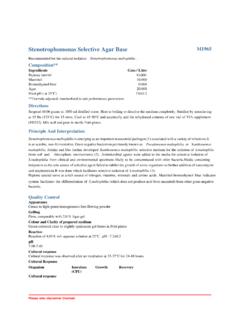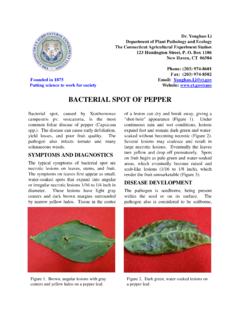Transcription of Handbook of Bean Diseases - The Learning Store
1 A3374 Handbook OFBean Hagedorn, D. A. lnglisFungus-incited Foliage DiseasesAlternaria Leaf SpotAngular Leaf SpotAnthracnoseAscochyta Leaf and Pod SpotPowdery MildewRustWhite Mold567891011 Preface and AcknowledgmentsiBacterial Diseases 1 Bacterial Brown Spot 2 Bacterial Wilt 3 Common Blight 4 Halo Blight1213141516 Root and Stem DiseasesAshy Stem BlightFusarium Root RotPythium Root RotRhizoctonia Root RotRoot-Knot Nematode17181920 Virus DiseasesCommon MosaicCurly TopGolden MosaicYellow MosaicNon-Parasitic Diseases2122232424 BaldheadNutrient Deficiency and ToxicityOzone InjurySunscaldWind Injury25 Selected Publications on bean
2 DiseasesCONTENTSP reface andAcknowledgmentsThis Handbook OF bean Diseases is published to pro-vide essential scientific information and visual guidance inidentifying the most common Diseases of bean , Phaseolusvulgaris especially those of canning and freezing known bean Diseases could not be included because ofthe expense. Minor and rarely occurring Diseases , as well asthose peculiar to isolated areas of other parts of the world,have been omitted. Information on occurrence, symptoms,cause, transmission, environmental factors, cultivar reaction,control and literature references are presented in an outlineform.
3 It is not the purpose of this publication to give a com-plete treatise on the disease . Instead, we hope this handbookwilI be helpful to those who want to identify a bean disease ,understand why it occurs and determine a general approachto control. Further information on bean Diseases can be ob-tained from selected publications listed at the back of express sincere and grateful acknowledgment to The Fri-day Foundation, New Richmond, Wisconsin. The foundation sfunds made possible the publication of this Handbook . Thanksalso to Eugene Herrling and Steve Vicen for taking thephotographs, to Rand for technical assistance and reviewof the manuscript, to H.
4 F. Schwartz for the ashy stem blightphotographs, Kelling for nutritional disorder photographs, MacGuidwin for the root-knot nematode photograph, andto Stevenson and Williams for reviewing the J. lnglisJune 1986 Madison, WisconsinBACTERIAL DISEASES1 Bacterial Brown SpotOccurrence-Importance: Bacterial brown spot is the mosteconomically significant disease of processing beans in thenorth central region of the United States. It occurs in otherbean-growing areas in the United States and the : Small (1/8 to 3/8 in or 3 to 9 mm in diameter),oval, necrotic lesions are apparent on leaves. A narrow yellow-green zone of tissue may be seen surrounding the exudate (ooze) and water-soaking are rarely observedprior to necrosis.
5 The leaf tissue around the lesion may bepuckered. Lesions coalesce and their centers fall out, givingleaves a tattered appearance. On pods, dark brown lesions aregenerally small (1/16 to 1/8 in or 1 to 3 mm in diameter).necrotic, and cause pod malformation by inciting cessation ofgrowth of nearby : The bacterium, Pseudomonas syringae Seed transmission is very low and is rarely ofsignificance. Sources of primary infection are usually weed hostson which the bacterium survives as an epiphyte on leaf sur-faces. It can survive in plant debris for 1 year. Spread of thepathogen is by wind-blown rain or overhead sprinkler Factors: Overcast, cloudy, humid weatherfavors the disease , especially if such conditions immediatelyfollow rain or irrigation.
6 Moderate and warm temperatures areconducive to disease development. Such conditions favormultiplication of the bacterium on leaf surfaces. Plants injuredby high winds, hail or blowing sand are very susceptible Reaction: There are a number of resistant field beans,but resistant snap beans for processing are just now becomingavailable, following the recent release by University of Wisconsinplant pathologists of the first three resistant breeding : Crop rotation should be practiced. Spray withcopper-containing chemicals weekly after symptoms have beenobserved, particularly when weather conditions favor diseasedevelopment. Use resistant cultivars when ; Hagedorn, Epiphytic populations ofPseudomonas syringae on susceptible and resistant beanlines.
7 Phytopathology 71:547-550; , ; Hagedorn, ; Kelman, A.; Rand, survival of Pseudomonas syringae on hairy vetchin relation to epidemiology of bacterial brown spot of bean inWisconsin. Phytopathology 64:1330-1339; ,. ; Rand, Wisconsin (BBSR) 130 beanbreeding lines. HortScience 12:356; , J.; Arny, ; Upper, Use of an apparentthreshold population of Pseudomonas syringae to predict In-cidence and severity of brown spot of bean , Phytopathology74:1334-1339; , ; Hagedorn, Relationship of isolate source tovirulence of Pseudomonas syringae on Phaseolus 62:678-680; DISEASESB acterial WiltOccurrence-Importance: Bacterial wilt is of modest impor-tance and uncommon occurrence.
8 However, it has beenrepeatedly observed in the central United States and has beenreported in 14 states and several : Infected plants at first wilt temporarily during thewarmest part of the day but regain their normal appearanceduring cool periods. Eventually a gradual systemic wilting of theplant persists, and the plant dies after turning straw color. Asystemic dark-brown to black discoloration is apparent in thevascular tissue inside the root and lower hypocotyl. Stem cankersand water-soaked pods also occurCause-Spread: The bacterium Corynebacterium flaccumfacienscan be borne on seeds, where it can live for many years.
9 It canoverwinter in plant debris or on weeds. It has been reported tobe spread by surface irrigation water and by allow entrance into the Factors: The disease is favored by warmtemperatures of 90oF (32%) and dry weather. Since woundsprovide entry into the plants, blowing sand or hailstorms maylikely result in more Reaction: No known processing beans are resistant,but Emerson and Resistant Great No. Star are resistant fieldbean cultivars. Several USDA plant introductions and otherPhaseolus species are also : Use disease -free seed. Practice crop rotation. Useresistant , Relation of root-knot nematodes and irrigationwater to the incidence and dissemination of bacterial wilt ofbean.
10 Plant Dis. Reptr. 43:27-32; , ; Coyne, Characterization and variationof Xanthomonas and Corynebacterium incited Diseases ofbeans (Phaseolus vulgaris L.). Outubro 2:199-209; , ; Coyne, ; Singh, K. Population trendsand movement of Corynebacterium flaccumfaciens in tolerant and susceptible beans, Plant 48:823-827; DISEASES3 Common BlightOccurrence-importance: Common blight is a serious diseasein many of the important snap and dry bean -producing regionsof the world. Although its effect on yield is difficult to estimate,workers have reported losses to be in the range of 10 to 45%Symptoms: Symptoms on the leaves first appear as water-soaked spots.








